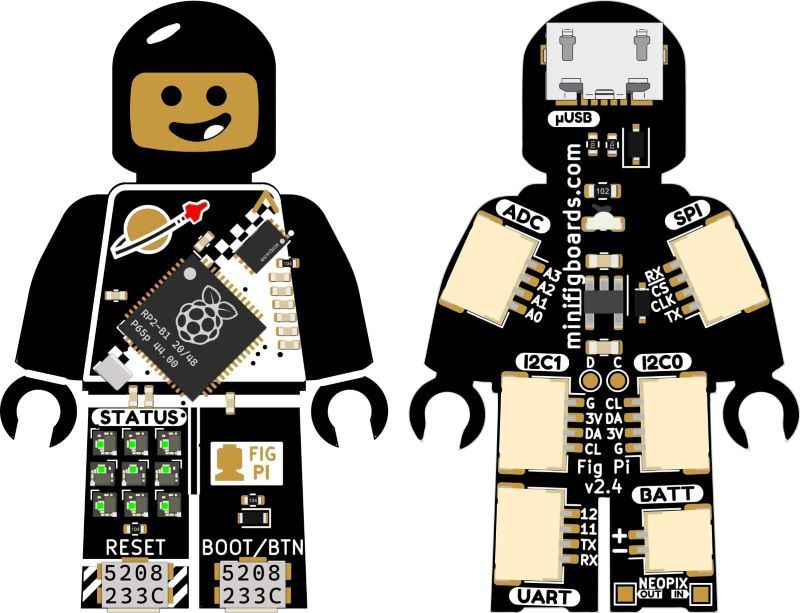
FigPi by Benjamin Shockley
Fig Pi is a minifigure-sized development board based on the Raspberry Pi Foundation RP2040 Dual Cortex®-M0+ MCU running at 133Mhz with 16 I/O, one built-in LED around back, a 3x3 matrix of RGB LEDs, built-in Button, and an extra 2MB of memory. Additionally, the Fig Pi has STEMMA QT/Qwiic 4-pin JST SH connectors on the back that support two I2C ST QT/ QW connectors, an SPI connector, ADC connector, Digital connector, and a battery connector (2-pin JST SH).
Features
- RP2040 is a low-cost, high-performance microcontroller device with flexible digital interfaces. Key features:
- Dual Cortex M0+ processor cores, up to 133MHz
- 264kB of embedded SRAM in 6 banks
- 30 multifunction GPIO
- 6 dedicated IO for SPI Flash (supporting XIP)
- Dedicated hardware for commonly used peripherals
- Programmable IO for extended peripheral support
- 4 channel ADC with internal temperature sensor, 500ksps, 12-bit conversion
- USB 1.1 Host/Device
- 2MB On Board Memory
- Micro-USB Connector
- 3.3V LDO Power
- Low Dropout Voltage (250-320mV at 600mA
- Rated 600mA Output Current
- High Output Voltage Accuracy (±2% typical)
- Over-Current and Over-Temperature Protection
- Built in RED LED accessible in and CircuitPython
- BOARD.LED
- Built in RGB LED 3x3 Matrix
- Uses Neopixel CP Library
- Self-Contained Driver/RGB LED
- Only requires one dedicated PIN
- Built in RESET Button
- Built-In BOOT/User Button
- 16 Total I/O Pins
- 4 Analog Input Pins
- 16 Digital Pins - All Support PWM
- 1 UART Interface
- 2 I2C Interfaces
- 1 SPI Interface
- Accessed via 4 pin JST SH connectors - STEMMA QT and QWIIC compatible for I2C interfaces
- U2F Bootloader - Appears like a USB Drive on your computer.
- CircuitPython Compatible
- Minifigure Shaped Board
- Approximately 0.95×1.55 inches (24.21×39.32 mm)
- 2-Layer, High Quality PCB
- Multiple Colors
Learn More
Contribute
Have some info to add for this board? Edit the source for this page here.
CircuitPython 9.2.8
This is the latest stable release of CircuitPython that will work with the FigPi. Use this release if you are new to CircuitPython.
Modules included in this download
_asyncio _bleio _pixelmap adafruit_bus_device adafruit_pixelbuf aesio alarm analogbufio analogio array atexit audiobusio audiocore audiomixer audiomp3 audiopwmio binascii bitbangio bitmapfilter bitmaptools bitops board builtins builtins.pow3 busdisplay busio busio.SPI busio.UART codeop collections countio digitalio displayio epaperdisplay errno floppyio fontio fourwire framebufferio getpass gifio hashlib i2cdisplaybus i2ctarget imagecapture io jpegio json keypad keypad.KeyMatrix keypad.Keys keypad.ShiftRegisterKeys keypad_demux keypad_demux.DemuxKeyMatrix locale math memorymap microcontroller msgpack neopixel_write nvm onewireio os os.getenv paralleldisplaybus pulseio pwmio qrio rainbowio random re rgbmatrix rotaryio rp2pio rtc sdcardio select sharpdisplay storage struct supervisor synthio sys terminalio tilepalettemapper time touchio traceback ulab usb usb_cdc usb_hid usb_host usb_midi usb_video vectorio warnings watchdog zlibFeatures: STEMMA QT/QWIIC
CircuitPython 10.0.0-beta.0
This is the latest development release of CircuitPython that will work with the FigPi.
Alpha development releases are early releases. They are unfinished, are likely to have bugs, and the features they provide may change. Beta releases may have some bugs and unfinished features, but should be suitable for many uses. A Release Candidate (rc) release is considered done and will become the next stable release, assuming no further issues are found.
Please try alpha, beta, and rc releases if you are able. Your testing is invaluable: it helps us uncover and find issues quickly.
Release Notes for 10.0.0-beta.0
Modules included in this download
_asyncio _bleio _bleio (HCI co-processor) _pixelmap adafruit_bus_device adafruit_pixelbuf aesio alarm analogbufio analogio array atexit audiobusio audiocore audiomixer audiomp3 audiopwmio binascii bitbangio bitmapfilter bitmaptools bitops board builtins builtins.pow3 busdisplay busio busio.SPI busio.UART codeop collections countio digitalio displayio epaperdisplay errno floppyio fontio fourwire framebufferio getpass gifio hashlib i2cdisplaybus i2ctarget imagecapture io jpegio json keypad keypad.KeyMatrix keypad.Keys keypad.ShiftRegisterKeys keypad_demux keypad_demux.DemuxKeyMatrix locale lvfontio math memorymap microcontroller msgpack neopixel_write nvm onewireio os os.getenv paralleldisplaybus pulseio pwmio qrio rainbowio random re rgbmatrix rotaryio rp2pio rtc sdcardio select sharpdisplay storage struct supervisor synthio sys terminalio tilepalettemapper time touchio traceback ulab usb usb_cdc usb_hid usb_host usb_midi usb_video vectorio warnings watchdog zlibFeatures: STEMMA QT/QWIIC
Absolute Newest
Every time we commit new code to CircuitPython we automatically build binaries for each board and language. The binaries are stored on Amazon S3, organized by board, and then by language. These releases are even newer than the development release listed above. Try them if you want the absolute latest and are feeling daring or want to see if a problem has been fixed.
Previous Versions of CircuitPython
All previous releases of CircuitPython are available for download from Amazon S3 through the button below. For very old releases, look in the OLD/ folder for each board. Release notes for each release are available at GitHub button below.
Older releases are useful for testing if you something appears to be broken in a newer release but used to work, or if you have older code that depends on features only available in an older release. Otherwise we recommend using the latest stable release.
